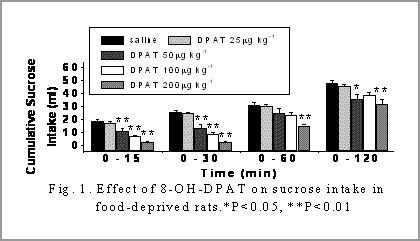The effects of the 5-HT1A receptor agonist 8-OH-DPAT on sucrose and saccharine consumption in food deprived rats It has been previously shown that the 5-HT1A receptor agonists decrease food intake in food-deprived rats given solid food (Ebenezer, 1992), by a 5-HT 1A receptor-mediated mechanism of action (Arkle et al., 2000). In the present study we examined the dose-related effects of 8-hydroxy-2-(di-N-propyl- amino)-tetralin (8-OH-DPAT) on the consumption of a sucrose solution (a nutritive carbohydrate source) and a non-nutritive sweetened solution made from saccharine in food deprived rats to test whether the hypophagia elicited by the 5-HT 1A receptor agonist is behaviourally specific for a nutritive source and not palatability. Male Wistar rats (n=12, b.wt. 260 - 350g) were divided into two equal groups, a sucrose group (n=6) and a saccharine group (n=6). The animals were fasted for 22h and given 4 training sessions during which time they were placed singly in experimental cages with free access to either sucrose solution (6% w/ v) or saccharine solution (0.3%w/ v) according to their designated group. The sucrose and saccharine solutions were matched for degree of “sweetness”. During experimental sessions, the rats in each group were injected s.c. with either saline or 8-OH-DPAT (25 – 200 μg kg-1) in a repeated measures design and placed separately in the experimental cages with access to either sucrose or saccharine solutions. Cumulative fluid intake was measured at intervals over 120 min. Three to four days separated each trial. The data were analysed by ANOVA and post-hoc Dunnett’s test. 8-OH-DPAT caused a dose-dependent reduction in the consumption of sucrose solution (see Fig. 1). By contrast, 8-OH-DPAT, in the range 25 – 100 μg kg-1 produced no significant effects on the consumption of saccharine solution. Only the 200 μg kg-1 dose significantly reduced cumulative saccharine consumption during the first 60 min after presentation (83 % reduction at 60 min; P<0.01). This dose produced abnormal behaviours, which included low body posture and head weaving, and this may have accounted for the significant decreases observed in both saccharine and sucrose consumption. The lower doses did not elicit these abnormal behaviours. It is noteworthy that the overall consumption of saccharine at 120 min was lower than that of sucrose by approximately 46 %. During the first exposure, however, the rats drank roughly equal amounts of both solutions. It is likely that the animals exposed to saccharine rapidly detected that this was a non-nutritive source from feedback systems governing satiety and lowered their intake accordingly. The results of this study show that low doses of 8-OH-DPAT decrease consumption of sucrose solution but not saccharine solution in fasted rats. These findings suggest that the hypophagia elicited 8-OH-DPAT is dependent on the nutritive value of the solution consumed and not on palatability per se.
Arkle, M.J. et al. (2000) Eur. J. Pharmacol., 408, 273 – 276. |
|


